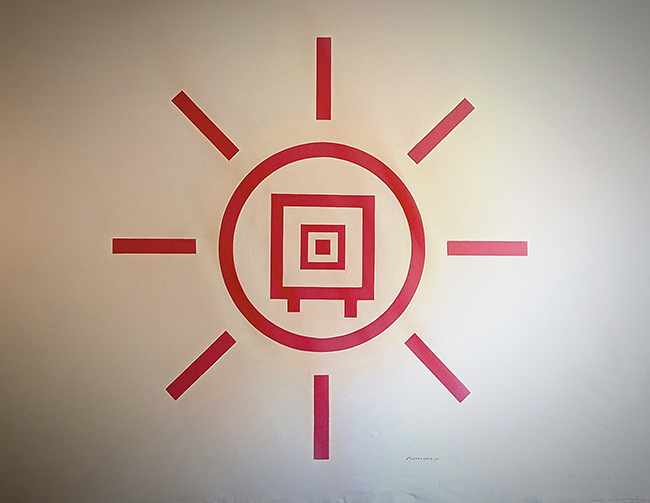Nicola Mastroserio does not chase trends. He does not cater to the art market’s hunger for commodification. Instead, he pursues something deeper—an exploration of reality that resists easy answers. His work is a meditation on existence, a quiet but persistent questioning of the nature of life, intelligence, and the unseen forces that shape our world. Mastroserio’s art is not decorative. It is not designed to flatter the eye or court popularity. Rather, it operates as a signpost pointing toward the inner journey, toward truths that do not bend to fashion. He is less concerned with what pleases and more concerned with what endures. Each piece is both a vision and an inquiry, something meant to awaken recognition within those who stand before it. His practice becomes an act of persistence, a call to look deeper, beyond surface patterns, and find the threads that connect us all.
UNIVERSAL SYMBOL OF LOVE
This particular work carries within it what Mastroserio calls the Universal Symbol of Love. It shines with love—not a sentimental love, but a force that shapes the world at its foundation. The work is clear in its intention: to remind us that no human being should doubt the path of life. Love, in its most essential form, is that path.
At first glance, the image feels simple: geometric forms, radiating lines, a sense of balance. But the more you stand before it, the more its meaning unfolds. The square within the circle, the radiating beams, the layered interior—each element points toward unity. Mastroserio is not playing with symbols arbitrarily. He is offering a language that speaks without needing translation. It is visual, immediate, universal.
For him, this symbol is not just a composition. It is the essence of the One that lives in all things. It indicates the union between all beings. It reminds us that we are bound together, brothers and sisters within a single existence. In this way, the piece does not simply decorate a wall. It functions more like a beacon, asking us to participate in a universal collaboration that transcends difference.
Mastroserio insists that the Universal Symbol of Love is not ambiguous. It leaves no room for interpretation. In a time when much art revels in uncertainty, this clarity feels unusual. The work is spiritual, direct, uncompromising. It insists that life and love are not separate but joined, as if two sides of the same current.

Everything that exists, the work suggests, is supported by one force—Love. Not as metaphor, but as reality. In that sense, the piece does not just illustrate a concept. It becomes a declaration, a clear direction for the future of humanity. It carries values we often talk about but rarely embody: Peace, Love, Charity. These are not optional ideals but necessary coordinates, given “according to the will of Heaven,” as Mastroserio himself describes.
Standing before this work, the effect is steadying. It strips away distraction and places the viewer in front of a single choice: to follow the path of love, or to continue wandering in division. The radiating beams feel like extensions of light, as if they were reaching outward to encompass everything in their path. The central form, with its nested squares, draws the gaze inward, suggesting depth within depth, a journey toward the center of being.
For Mastroserio, this is not about cultural symbols or intellectual games. The work points beyond thought, beyond currents of philosophy or religion, beyond the divisions of culture. It suggests that the human future will not be determined by argument, but by alignment with a single orientation—Love.
This clarity can feel radical in a world so fractured by politics, ideologies, and competition. Yet Mastroserio’s symbol stands quietly, offering no spectacle, no shock value. It is calm, direct, unwavering. Its power lies in its simplicity, its refusal to dilute its message.
The Universal Symbol of Love speaks as both reminder and prophecy. It reminds us that life itself is already grounded in love, that we are already connected, even when we forget. And it prophesies that healing for humanity can only come by recognizing this truth and living in accord with it.
Nicola Mastroserio has given this work as a compass. Not a map of routes, but a single, unwavering direction. Everything else, he suggests, is distraction. The path is clear. The path is love.

